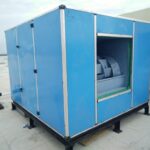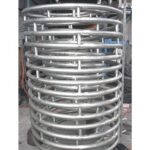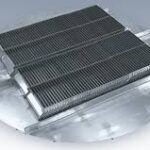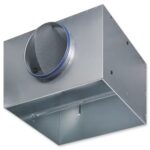Direct Expansion Coil
Direct Expansion Coils also known as evaporator coils, are heat exchangers used in HVAC systems where refrigerant directly absorbs heat from the air passing over the coils, causing the refrigerant to evaporate and cool the air. This process offers efficient and effective cooling, making DX coils a common component in air conditioning and refrigeration systems. Their compact design and direct heat transfer capabilities enhance system performance and are widely utilized in residential and commercial applications.

Direct Expansion Coil
Functions
Cooling Function:
- DX coils are primarily designed to cool air in HVAC systems. They achieve this by circulating refrigerant through a network of tubes within the coil. As warm air from the space passes over the coil, the refrigerant inside absorbs heat from the air.
Dehumidification Function:
- DX coils also contribute to dehumidification by cooling the air below its dew point temperature. As warm, humid air passes over the cold DX coil, moisture condenses on the coil’s surface. This condensed moisture (condensate) is collected and drained away from the system.
Air Conditioning Applications:
- DX coils are integral to various air conditioning applications, including residential and commercial HVAC systems, refrigeration units, and industrial cooling processes.
Direct Expansion Coil
Types and Applications
| Type of DX Coil | Description | Applications |
|---|---|---|
| Cooling Coils | Designed to cool the air by evaporating refrigerant within the coil. | Air conditioning systems, refrigeration units |
| Heating Coils | Utilize refrigerant to transfer heat to the air, typically used in heat pump systems. | Heat pumps, HVAC systems |
| Dehumidification Coils | Remove moisture from the air by cooling it below its dew point. | Humidity control systems, HVAC applications |
| Reheat Coils | Used to slightly reheat air that has been cooled and dehumidified to the desired temperature. | Dehumidification systems, HVAC systems |
| Evaporator Coils | Specific type of cooling coil where refrigerant evaporates to absorb heat from the air. | Split-system air conditioners, packaged units |
| Condenser Coils | Reverse of evaporator coils, where refrigerant releases heat and condenses back into liquid. | Heat pumps, refrigeration units, air conditioners |
| Multicircuit Coils | Have multiple circuits for refrigerant flow, providing flexibility and capacity control. | Large commercial HVAC systems, variable load applications |
| Slant Coils | Coils designed with a slant to enhance air distribution and heat transfer. | Air handlers, rooftop units, split systems |
Other Air Handling Units We Manufacture
Air Washer Unit
Air Washer Unit is a type of HVAC equipment that combines air cleaning and humidification functions in one system. It uses a water-saturated filter or media

Heat Transfer Coils
Heat Transfer Coils are components used in HVAC systems to either add or remove heat from the air flowing through them. They consist of tubes that carry a heating or cooling medium

Mist Eliminators
Mist Eliminators, also known as demisters or mist extractors, are devices used to remove liquid droplets (mist) from gas streams. They work by using various mechanisms

Plenum Box
Plenum Box serves as a junction point in HVAC ductwork, collecting conditioned air from a main supply duct and evenly distributing it to multiple outlets or diffusers throughout a building.

Volume Control Dampers
Volume Control Dampers are mechanical devices used in HVAC systems to regulate and control the volume of airflow within ductwork. They adjust the size of the duct opening, typically through adjustable blades

